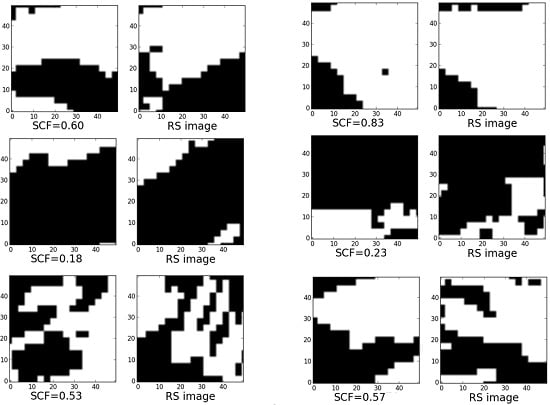Downscaling Snow Cover Fraction Data in Mountainous Regions Based on Simulated Inhomogeneous Snow Ablation
Abstract
:1. Introduction
- (1)
- Snow is always present where it is not easily ablated, such as northern slopes and high-altitude regions. In a grid with complex terrain, snow ablation capacities differ from topographies.
- (2)
- Inhomogeneous snow ablation capacities can be empirically simulated based on dominant meteorological factors, such as solar radiation and air temperature. Solar radiation and air temperature can be accurately interpolated using a limited number of station observations [27].
- (3)
- Comparing modeled ablation heterogeneities at the subgrid scale enables one to allocate snow positions where snow is not easily ablated under a given grid-scale SCF.
2. Methodology
2.1. Problem Description
- (1)
- A grid measuring L by L and containing n times n cells.
- (2)
- A grid-scale SCF (≤100%) of the grid at time t.
- (3)
- A subgrid-scale DEM with a spatial resolution of L/n.
- (4)
- A subgrid-scale time series of solar radiation and air temperature in a typical snow season.
2.2. Calculation of Potential Snow Ablation Capacities
2.3. From Distributed Ps to Subgrid-Scale Snow Locations

2.4. K Value Determination and Accuracy Assessment
2.4.1. Overall Accuracy
2.4.2. Kappa Coefficient
2.4.3. Evaluation of the RMSE
3. Data
3.1. Remotely Sensed Snow Cover Data
3.1.1. Real Snow Distribution Maps Based on Multi-Source Remote Sensing Data
| Source | Number | Date | Resolution | |
|---|---|---|---|---|
| PROBA/CHRIS | 12 | 2008.11.18 2008.11.19 2009.01.10 2009.03.30 2009.03.31 2009.11.06 | 2009.11.14 2009.11.23 2009.11.24 2009.12.29 2010.01.07 2010.02.19 | 30 m |
| Landsat/EO-1 | 4 | 2008.03.17 2008.03.22 | 2008.03.27 2008.04.01 | 30 m |
| Landsat/TM | 2 | 2008.03.17 | 2009.09.28 | 30 m |
| MODIS/Terra | 18 | All dates above | 500 m | |
3.1.2. SCF Data
- (1)
- Downscaling the 30-m-resolution binary snow map to a 10-m-resolution binary snow map via linear interpolation.
- (2)
- Counting the number of snow-covered grids in each region using 50 × 50 grids of the 10-m resolution binary snow map. Each region with 50 × 50 grids represents a 500-m-resolution grid.
- (3)
- Computing the snow-covered area in each 500-m-resolution grid to determine the 500-m-resolution SCF field.
3.2. Study Region
3.2.1. Topographic and Meteorological Data
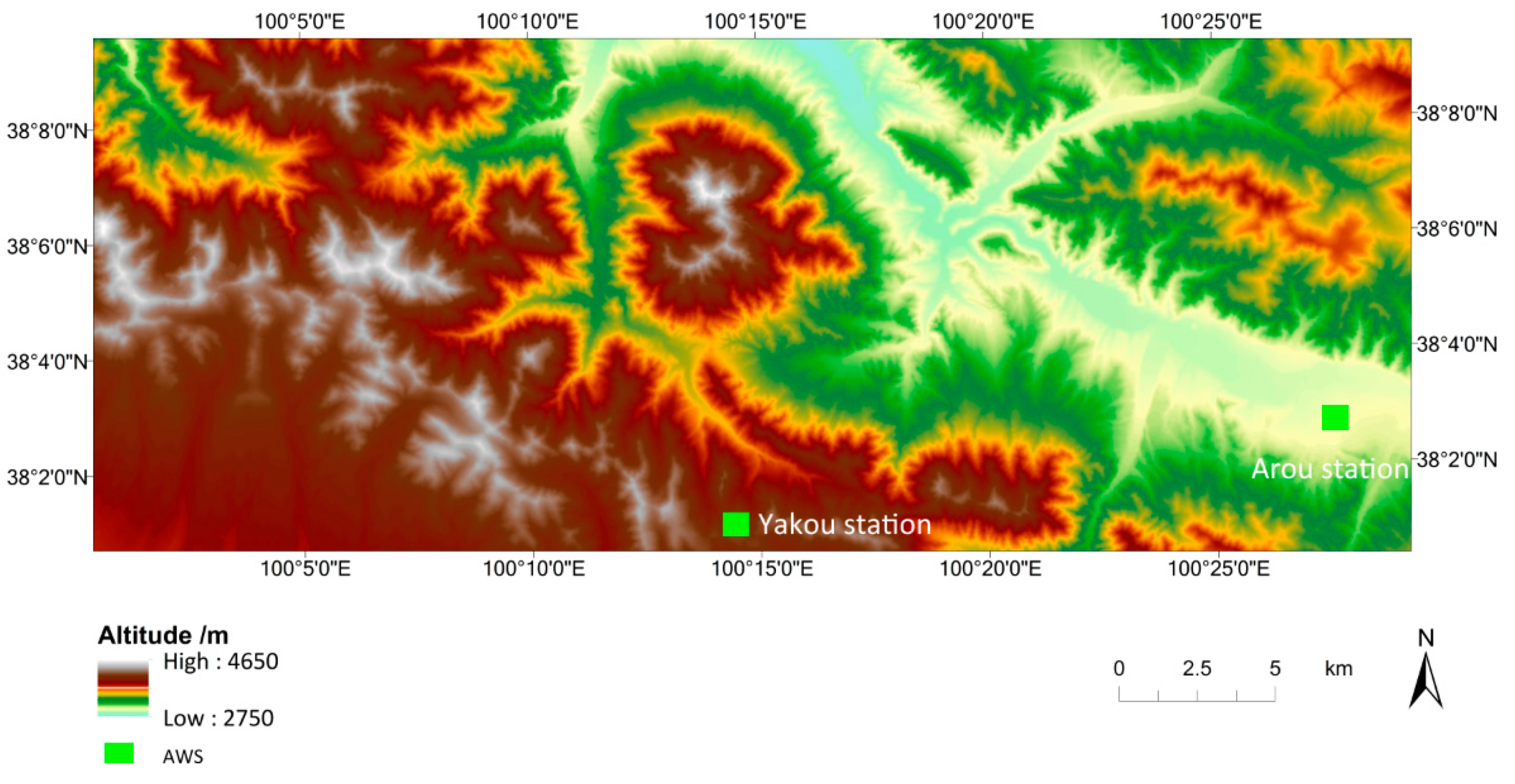
3.2.2. Spatial Interpolation of Solar Radiation and Air Temperature
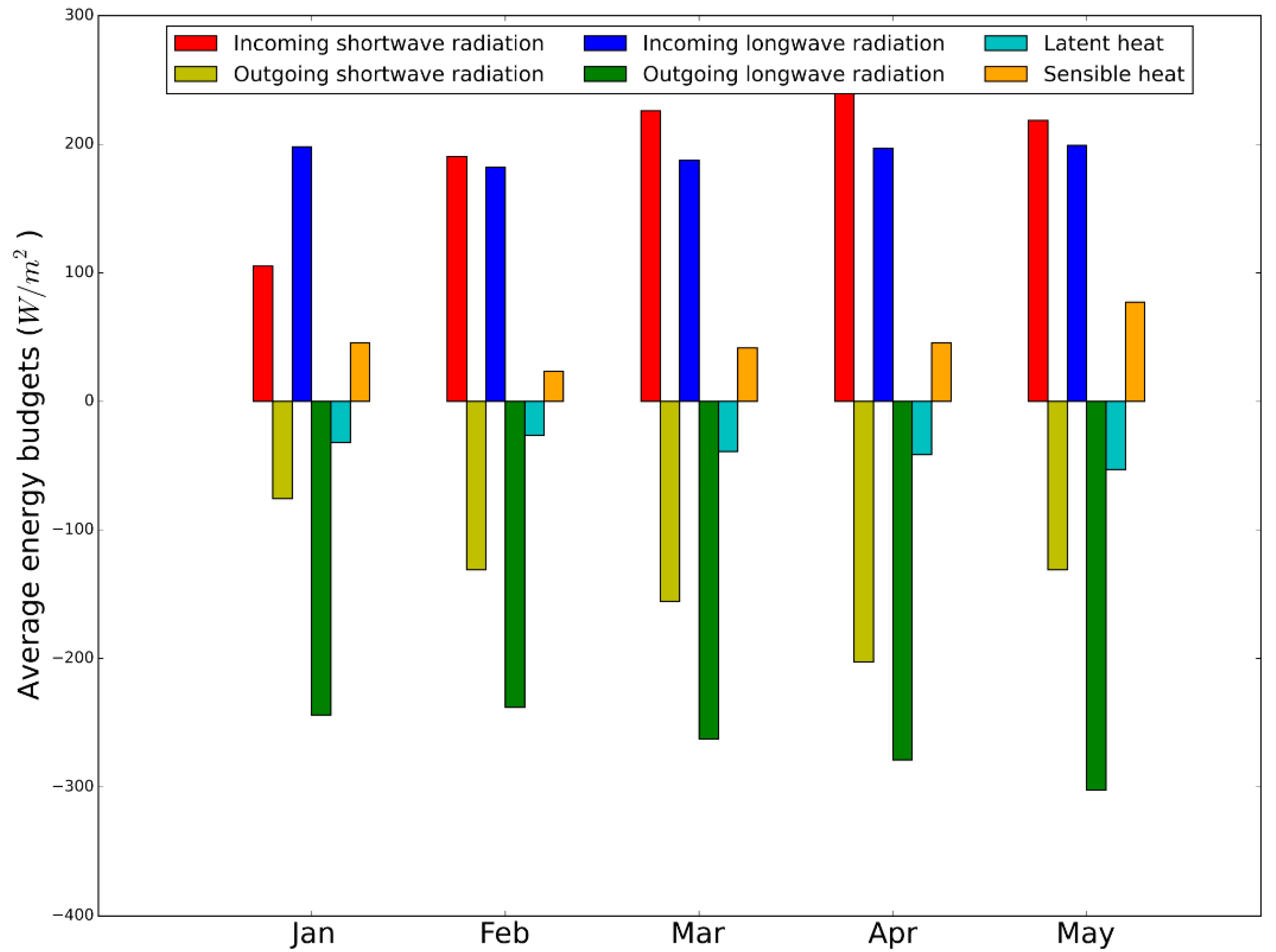
4. Results
4.1. Determining K
| K Value | Mean Overall Accuracy | Mean Kappa Coefficient | Mean RMSE between the SLopes of DS and RS Subgrids (°) | Mean RMSE between the Sine of the Aspects of DS and RS Subgrids |
|---|---|---|---|---|
| 0.000 | 0.63 | 0.42 | 4.5 | 0.388 |
| 0.001 | 0.64 | 0.43 | 4.3 | 0.370 |
| 0.002 | 0.65 | 0.44 | 4.1 | 0.349 |
| 0.003 | 0.66 | 0.46 | 4.0 | 0.337 |
| 0.004 | 0.67 | 0.47 | 3.9 | 0.331 |
| 0.005 | 0.67 | 0.48 | 3.9 | 0.332 |
| 0.006 | 0.68 | 0.49 | 3.9 | 0.330 |
| 0.007 | 0.68 | 0.49 | 3.8 | 0.329 |
| 0.008 | 0.69 | 0.50 | 3.8 | 0.329 |
| 0.009 | 0.69 | 0.51 | 3.8 | 0.330 |
| 0.010 | 0.70 | 0.51 | 3.8 | 0.339 |
| 0.011 | 0.70 | 0.52 | 3.7 | 0.343 |
| 0.012 | 0.70 | 0.52 | 3.7 | 0.344 |
| 0.013 | 0.70 | 0.52 | 3.7 | 0.349 |
| 0.014 | 0.70 | 0.53 | 3.8 | 0.352 |
| 0.015 | 0.70 | 0.53 | 3.8 | 0.356 |
| 0.016 | 0.71 | 0.53 | 3.8 | 0.359 |
| 0.017 | 0.71 | 0.53 | 3.8 | 0.359 |
| 0.018 | 0.71 | 0.53 | 3.8 | 0.362 |
| 0.019 | 0.71 | 0.53 | 3.7 | 0.366 |
| 0.020 | 0.71 | 0.53 | 3.7 | 0.368 |
| 0.021 | 0.71 | 0.53 | 3.8 | 0.369 |
| 0.022 | 0.71 | 0.53 | 3.8 | 0.372 |
| 0.023 | 0.71 | 0.53 | 3.8 | 0.372 |
| 0.024 | 0.71 | 0.53 | 3.8 | 0.374 |
| 0.025 | 0.71 | 0.53 | 3.8 | 0.375 |
| 0.026 | 0.71 | 0.53 | 3.8 | 0.377 |
| 0.027 | 0.71 | 0.53 | 3.8 | 0.380 |
| 0.028 | 0.71 | 0.53 | 3.8 | 0.381 |
| 0.029 | 0.71 | 0.53 | 3.8 | 0.383 |
| 0.030 | 0.71 | 0.53 | 3.8 | 0.383 |
- (1)
- In this study, air temperature and solar radiation differences are understood to affect inhomogeneous snow distributions at the subgrid scale. Temperature differences at different elevations may play a dominant role in causing inhomogeneities. Solar radiation associated with various slopes and aspects has a secondary role.
- (2)
- In determining K values, the accuracy of the downscaled aspect plays a more important role than the slope. When K is zero, the RMSEs between the slopes in different downscaled images range from 2.2° to 6.8°, with an average value of 4.7°; as K increases, the RMSE gradually decreases to a stable value with an average of 3.8°. The RMSEs for the sine of the aspect followed a different trend than those for the slopes, i.e., decreasing to minimum values and then increasing gradually. When K is zero, the RMSEs for the sine of the aspect range from 0.18 to 0.55, with an average of 0.40; when K is 0.007, the average RMSE reaches a minimum of 0.33. Thereafter, the RMSE gradually increases to 0.39. When K exceeds 0.014, the kappa coefficient and slope accuracy of the downscaled results exhibit no further improvement, and the aspect accuracy worsens. Thus, the accuracy of the aspect should be considered a decisive factor when determining K values when the slope and kappa coefficient accuracies become stable.
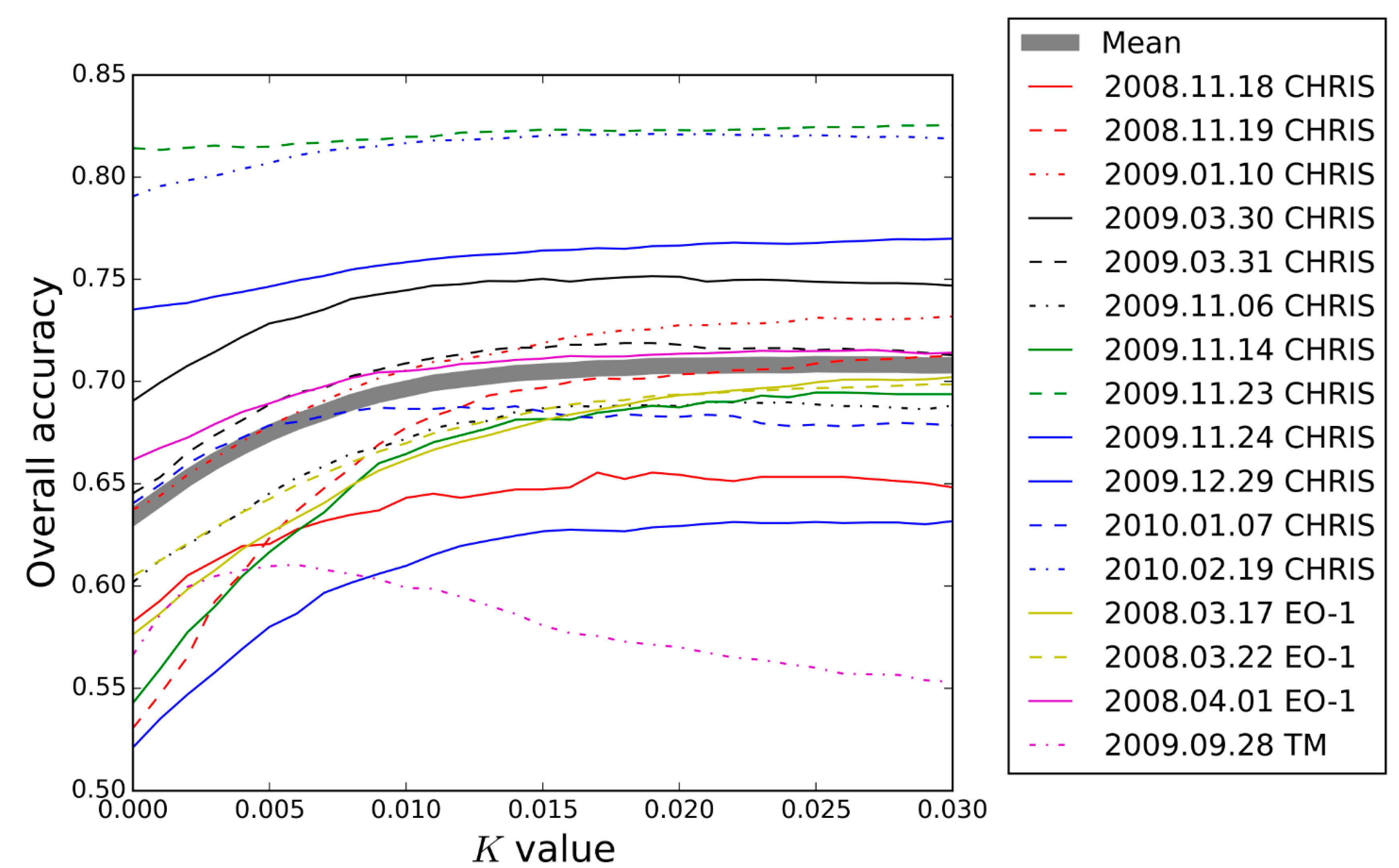
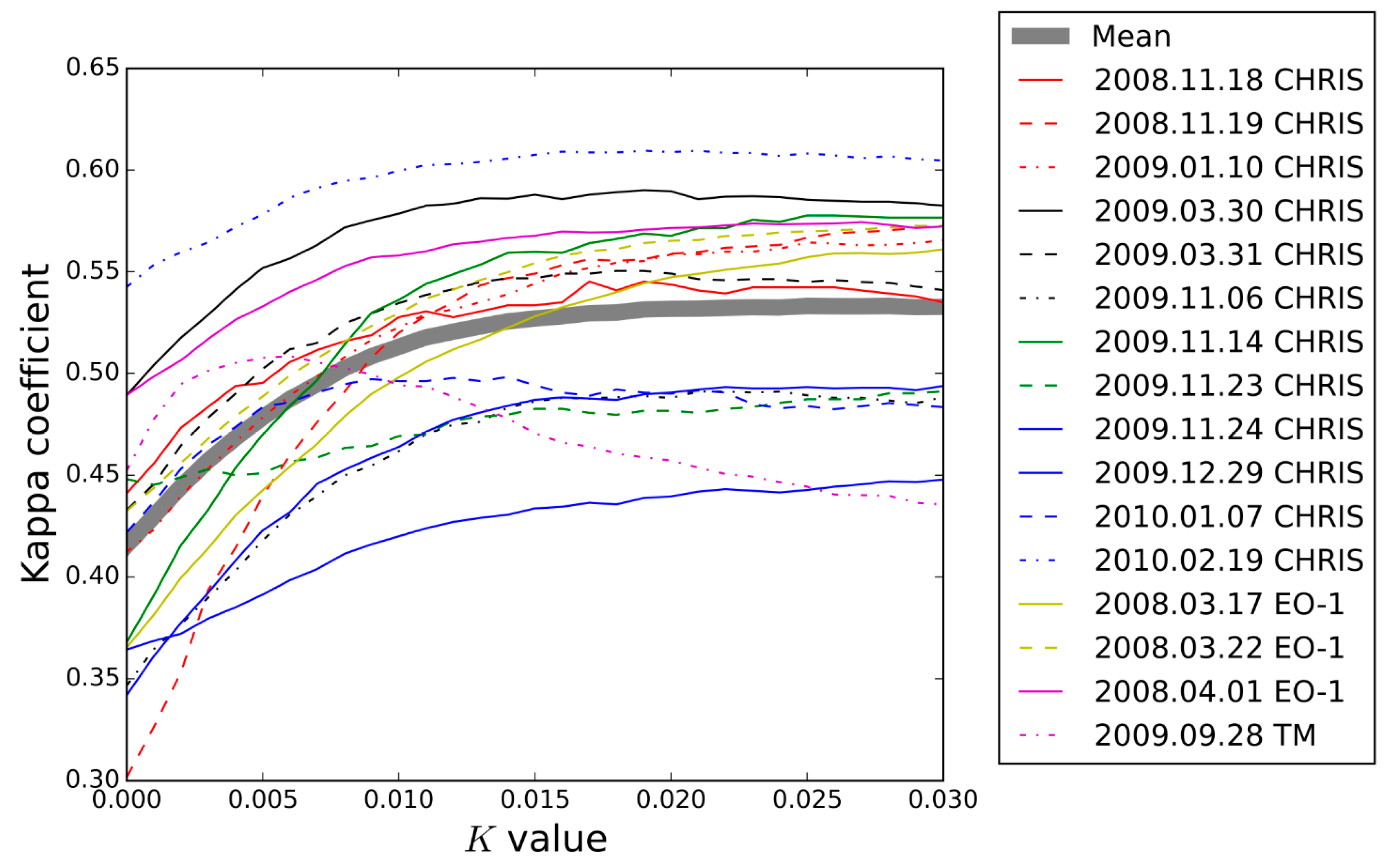
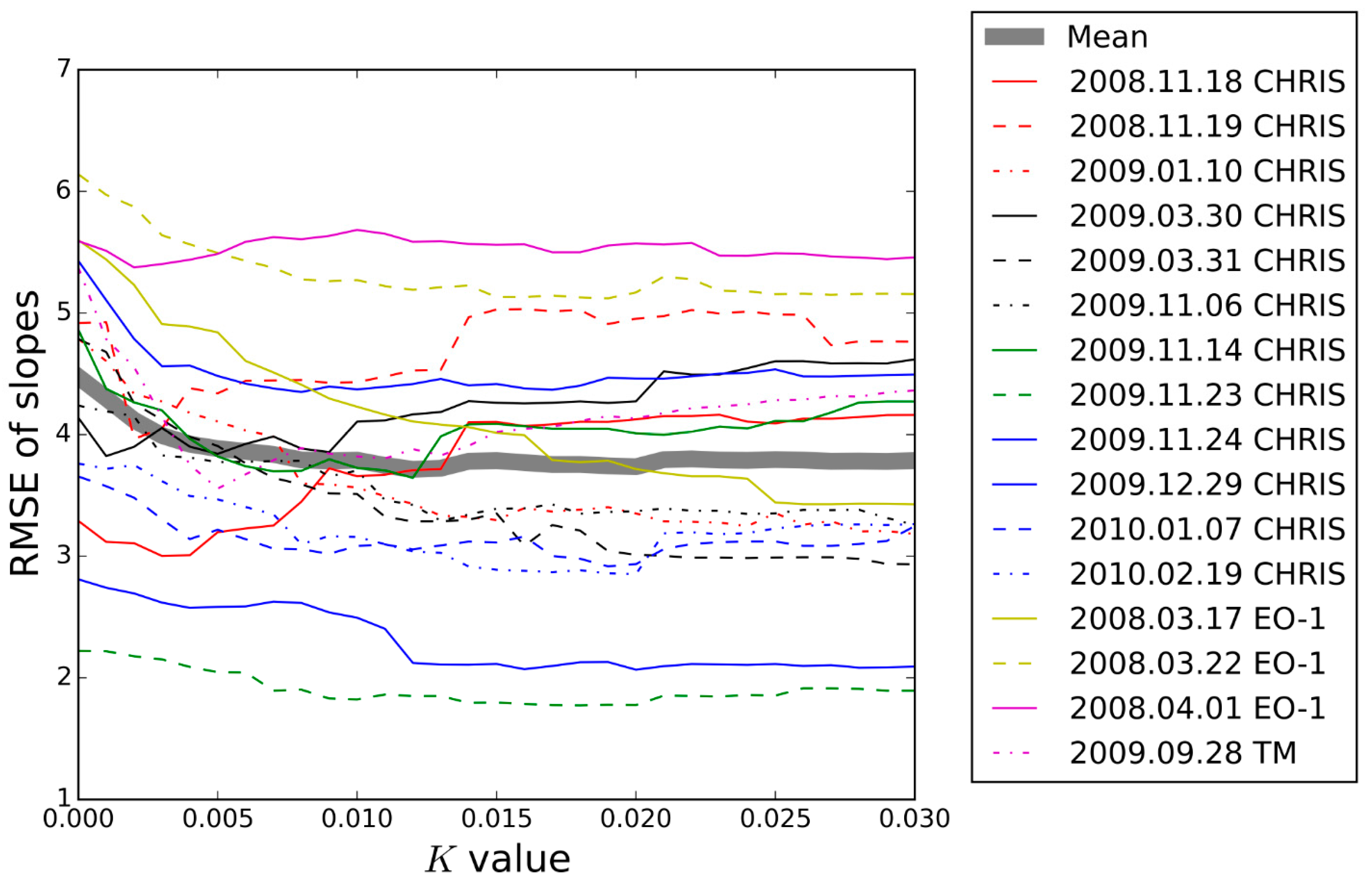

4.2. Downscaled Snow Map Accuracy Assessment
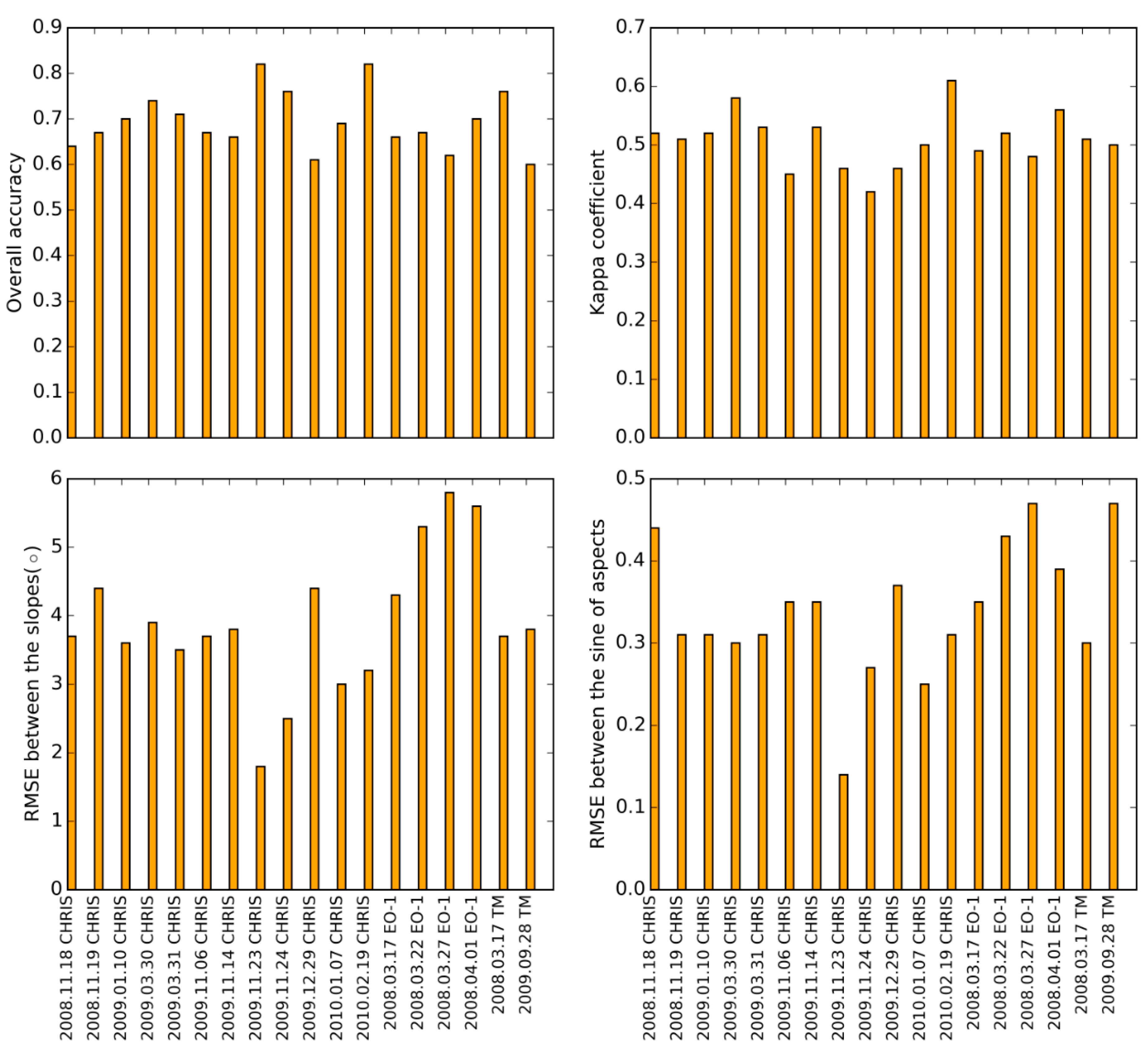

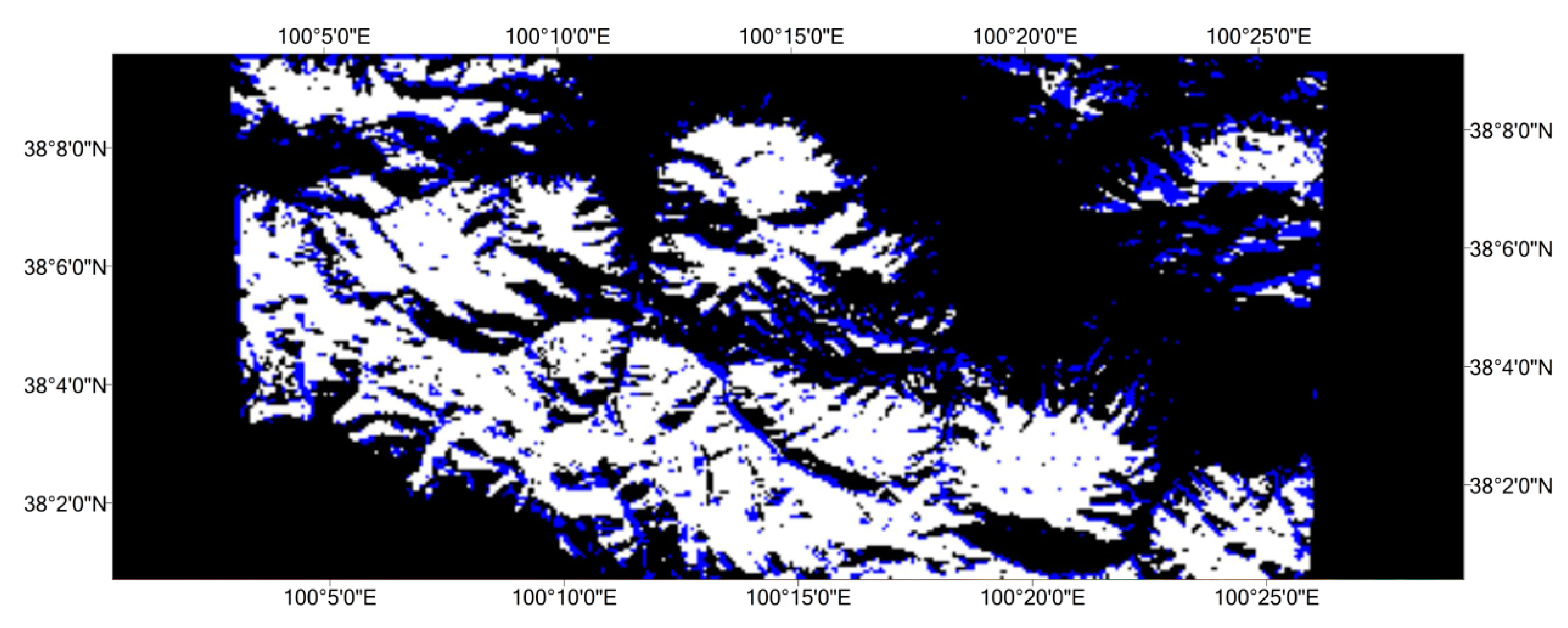
5. Discussion
5.1. Applicability of the Downscaled Method Driven by Air Temperature and Solar Radiation
5.2. Limitations of the Downscaling Method and Error Analysis
5.2.1. Spatial Scale Limit
5.2.2. Errors due to an Absence of Blowing Snow and Inhomogeneous Precipitation
5.2.3. Errors in the Employed Data
- (1)
- MODIS SCF products yield systematic underestimation, as shown in Figure 11. The SCF values across the region of different dates are compared with the “real” SCF obtained from high-resolution satellite images. Our results indicate that the underestimation occurs primarily where the snow cover fraction is relatively low and at lower elevations (Figure 12). Other studies in this region mentioned similar results. For example, Zhang et al. [50] reported that the SCF in the MODIS standard product is less than the “ground truth” obtained from ETM+ images with 30-m resolution, and the MODIS product fails to retrieve snow in the snow cover-transition areas with patchy snow. Rittger et al. [51] found that the MODIS SCF product is slightly underestimated in the Himalaya region. Fortunately, a few previous studies have generated strong retrieval results. For example, an improved endmember extraction method was employed to improve fractional snow cover mapping in our study region [50]. This method is based on the fast autonomous spectral endmember determination (N-FINDR) maximizing volume iteration algorithm and on orthogonal subspace projection theory. For MODIS data, the study reported a retrieved RMSE for the SCF of 0.14, which is superior to that of the MODIS standard fractional snow cover product (MOD10A1) [50]. Because this paper focuses on the downscaling method, we only analyze the influence of errors from MODIS standard products (MOD10A1) in the downscaling accuracy and do not involve other SCF products using different retrieval methods.
- (2)
- As expected, the errors from the MODIS product reduce the downscaled accuracy. The accuracy of the MODIS SCF is better, and the downscaled accuracy is closer to the best value using high-resolution images. For example (Figure 11), on 23 November 2009, the MODIS SCF of the study region is 0.70 and the CHRIS SCF is 0.80, whereas the overall accuracy (OA) of the downscaled snow map from the MODIS SCF product is 0.73 and the OA using CHRIS is 0.82. Both calculation results and accuracies are close. By contrast, on 24 November 2009, the MODIS SCF of the study region is 0.27 and the CHRIS SCF is 0.65, whereas the OA of the downscaled snow map using the MODIS product is 0.48 and the OA using CHRIS is 0.76. There is a large difference between the accuracies because the MODIS product dramatically underestimates the SCF value on that day. Overall, better accuracy of the MODIS SCF leads to better downscaling accuracy because there is less error in the MODIS product itself.
- (3)
- We also find that a higher SCF is related to higher downscaling accuracy of the MODIS products. For example, on 28 September 2009, the MODIS SCF of the study region is 0.01 and the CHRIS SCF is 0.06, whereas the OA of the downscaled snow map using the MODIS product is 0.16 and the OA using the TM is 0.60. In this case, the SCFs from MODIS and TM are close; however, the downscaled results different substantially. The underlying cause is still the misestimation associated with the MODIS SCF products in low-SCF regions, as mentioned earlier.
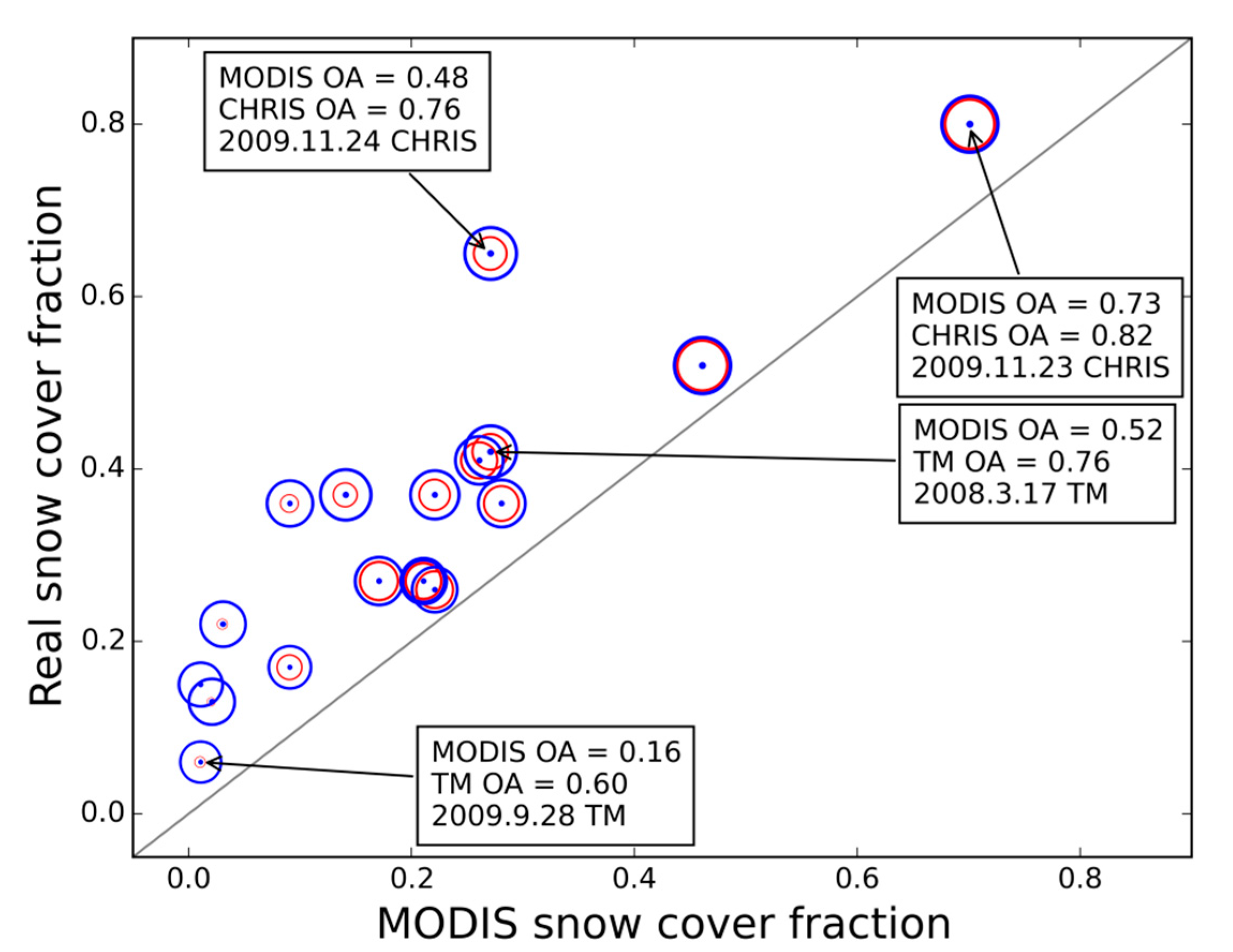
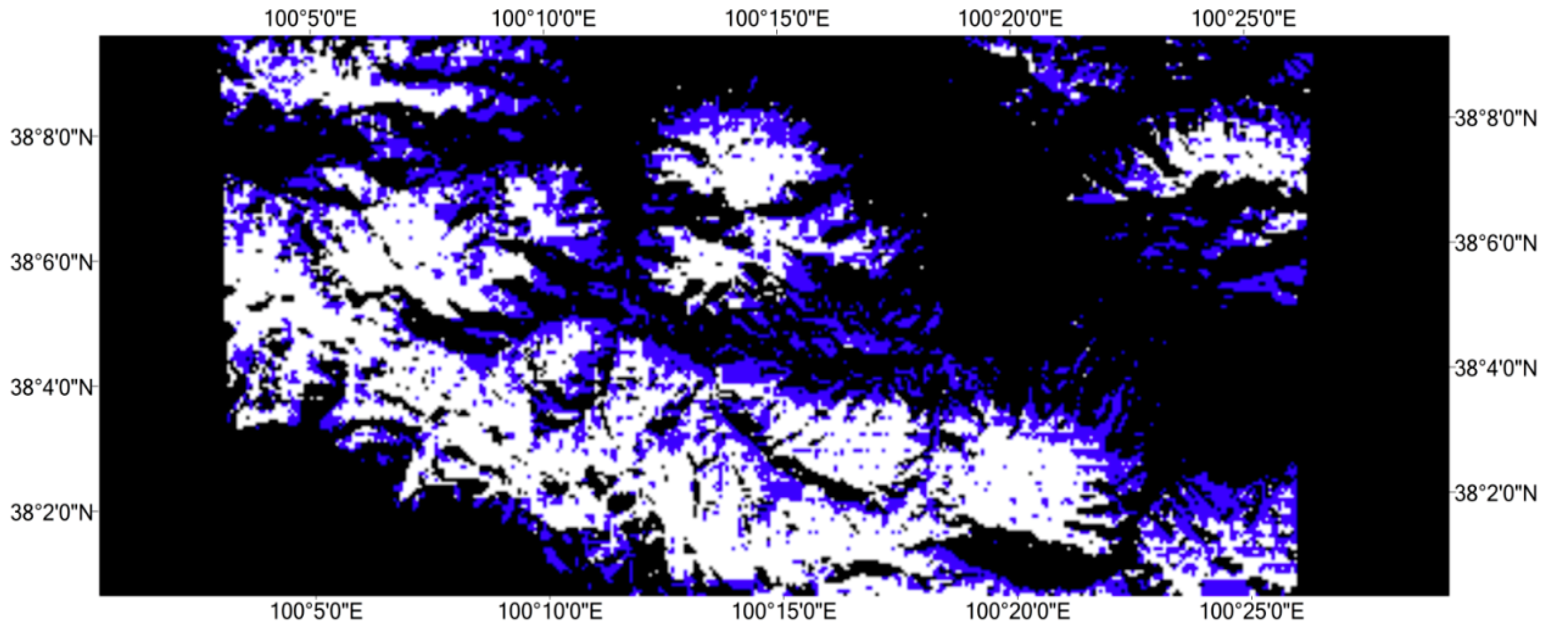
6. Conclusions
- (1)
- The downscaled method is suitable for reconstructing subgrid-scale snow distributions. Slope and aspect information for snow-covered areas can be retrieved with sufficient accuracy compared to the real information. Downscaled results may be used in hydrological simulations or in other studies that require more accurate snow distribution data.
- (2)
- This method can be applied to other similar mountainous regions. A spatial scale of 500 m is employed herein. Because most remotely sensed snow map products employ kilometer-based resolutions, the method can be used for such products (e.g., MODIS data). Only air temperature, solar radiation and DEM data are required. This simplicity ensures the applicability of this method to sparsely gauged mountainous regions.
- (3)
- Spatial scales must be considered when this method is generalized to other similar regions due to the different mechanisms that are important for snow distributions, data interpolation errors and vegetation heterogeneities. Blowing snow should be considered in areas where such patterns are prominent. If sophisticated physically based snow processes are considered while employing downscaling methods, the accuracy of the data should remain intact.
Acknowledgments
Author Contributions
Conflicts of Interest
References
- Li, X.; Cheng, G.D.; Jin, H.J.; Kang, E.S.; Che, T.; Jin, R.; Wu, L.Z.; Nan, Z.T.; Wang, J.; Shen, Y.P. Cryospheric change in China. Glob. Planet. Chang. 2008, 62, 210–218. [Google Scholar] [CrossRef]
- Li, H.Y.; Wang, J. Simulation of snow distribution and melt under cloudy conditions in an Alpine watershed. Hydrol. Earth Syst. Sci. 2011, 15, 2195–2203. [Google Scholar] [CrossRef]
- Qin, D.; Liu, S.; Li, P. Snow cover distribution, variability, and response to climate change in Western China. J. Clim. 2006, 19, 1820–1833. [Google Scholar]
- Cline, D.W.; Bales, R.C.; Dozier, J. Estimating the spatial distribution of snow in mountain basins using remote sensing and energy balance modeling. Water Resour. Res. 1998, 34, 1275–1285. [Google Scholar] [CrossRef]
- Yang, D.; Gao, B.; Jiao, Y.; Lei, H.; Zhang, Y.; Yang, H.; Cong, Z. A distributed scheme developed for eco-hydrological modeling in the upper Heihe River. Sci. China Earth Sci. 2015, 58, 36–45. [Google Scholar] [CrossRef]
- Dozier, J. A clear-sky spectral solar radiation model for snow-covered mountainous terrain. Water Resour. Res. 1980, 16, 709–718. [Google Scholar] [CrossRef]
- Hall, D.K.; Tait, A.B.; Foster, J.L.; Chang, A.T.C.; Allen, M. Intercomparison of satellite-derived snow-cover maps. Ann. Glaciol. 2000, 31, 369–376. [Google Scholar] [CrossRef]
- Czyzowska-Wisniewski, E.H.; van Leeuwen, W.J.D.; Hirschboeck, K.K.; Marsh, S.E.; Wisniewski, W.T. Fractional snow cover estimation in complex alpine-forested environments using an artificial neural network. Remote Sens. Environ. 2015, 156, 403–417. [Google Scholar] [CrossRef]
- Yang, J.; Jiang, L.; Ménard, C.B.; Luojus, K.; Lemmetyinen, J.; Pulliainen, J. Evaluation of snow products over the Tibetan Plateau. Hydrol. Process. 2015. [Google Scholar] [CrossRef]
- Rosenthal, W.; Dozier, J. Automated mapping of montane snow cover at subpixel resolution from the Landsat Thematic Mapper. Water Resour. Res. 1996, 32, 115–130. [Google Scholar] [CrossRef]
- Wang, J.; Li, H.X.; Hao, X.H.; Huang, X.D.; Hou, J.L.; Che, T.; Dai, L.Y.; Liang, T.G.; Huang, C.L.; Li, H.Y.; et al. Remote sensing for snow hydrology in China: Challenges and perspectives. J. Appl. Remote Sens. 2014, 8, 084687. [Google Scholar] [CrossRef]
- Arsenault, K.R.; Houser, P.R.; de Lannoy, G.J.M. Evaluation of the MODIS snow cover fraction product. Hydrol. Process. 2012, 28, 980–998. [Google Scholar] [CrossRef]
- Salomonson, V.V.; Appel, I. Estimating fractional snow cover from MODIS using the normalized difference snow index. Remote Sens. Environ. 2004, 89, 351–360. [Google Scholar] [CrossRef]
- Painter, T.H.; Rittger, K.; McKenzie, C.; Slaughter, P.; Davis, R.E.; Dozier, J. Retrieval of subpixel snow covered area, grain size, and albedo from MODIS. Remote Sens. Environ. 2009, 113, 868–879. [Google Scholar] [CrossRef]
- Homan, J.W.; Luce, C.H.; McNamara, J.P.; Glenn, N.F. Improvement of distributed snowmelt energy balance modeling with MODIS-based NDSI-derived fractional snow-covered area data. Hydrol. Process. 2011, 25, 650–660. [Google Scholar] [CrossRef]
- Zhang, G.Q.; Xie, H.J.; Yao, T.D.; Liang, T.G.; Kang, S.C. Snow cover dynamics of four lake basins over Tibetan Plateau using time series MODIS data (2001–2010). Water Resour. Res. 2012, 48, W10529. [Google Scholar] [CrossRef]
- Gao, Y.; Xie, H.; Lu, N.; Yao, T.; Liang, T. Toward advanced daily cloud-free snow cover and snow water equivalent products from Terra-Aqua MODIS and Aqua AMSR-E measurements. J. Hydrol. 2010, 385, 23–35. [Google Scholar] [CrossRef]
- Gafurov, A.; Bárdossy, A. Cloud removal methodology from MODIS snow cover product. Hydrol. Earth Syst. Sci. 2009, 13, 1361–1373. [Google Scholar] [CrossRef]
- Hall, D.K.; Riggs, G.A.; Foster, J.L.; Kumar, S.V. Development and evaluation of a cloud-gap-filled MODIS daily snow-cover product. Remote Sens. Environ. 2010, 114, 496–503. [Google Scholar] [CrossRef]
- Walters, R.D.; Watson, K.A.; Marshall, H.P.; McNamara, J.P.; Flores, A.N. A physiographic approach to downscaling fractional snow cover data in mountainous regions. Remote Sens. Environ. 2014, 152, 413–425. [Google Scholar] [CrossRef]
- Skaugen, T.; Randen, F. Modeling the spatial distribution of snow water equivalent, taking into account changes in snow-covered area. Ann. Glaciol. 2013, 54, 305–313. [Google Scholar] [CrossRef]
- Marchand, W.D.; Killingtveit, A. Statistical probability distribution of snow depth at the model sub-grid cell spatial scale. Hydrol. Process. 2005, 19, 355–369. [Google Scholar] [CrossRef]
- Liston, G.E. Representing subgrid snow cover heterogeneities in regional and global models. J. Clim. 2004, 17, 1381–1397. [Google Scholar] [CrossRef]
- Luce, C.H.; Tarboton, D.G. The application of depletion curves for parameterization of subgrid variability of snow. Hydrol. Process. 2004, 18, 1409–1422. [Google Scholar] [CrossRef]
- Kolberg, S.A.; Gottschalk, L. Updating of snow depletion curve with remote sensing data. Hydrol. Process. 2006, 20, 2363–2380. [Google Scholar] [CrossRef]
- Hebeler, F.; Purves, R.S. The influence of resolution and topographic uncertainty on melt modelling using hypsometric sub-grid parameterization. Hydrol. Process. 2008, 22, 3965–3979. [Google Scholar] [CrossRef] [Green Version]
- Liston, G.E.; Elder, K. A meteorological distribution system for high-resolution terrestrial modeling (MicroMet). J. Hydrometeorol. 2006, 7, 217–234. [Google Scholar] [CrossRef]
- Brubaker, K.; Rango, A.; Kustas, W. Incorporating radiation inputs into the snowmelt runoff model. Hydrol. Process. 1996, 10, 1329–1343. [Google Scholar] [CrossRef]
- Cazorzi, F.; Dalla Fontana, G. Snowmelt modelling by combining air temperature and a distributed radiation index. J. Hydrol. 1996, 181, 169–187. [Google Scholar] [CrossRef]
- Molotch, N.P.; Margulis, S.A. Estimating the distribution of snow water equivalent using remotely sensed snow cover data and a spatially distributed snowmelt model: A multi-resolution, multi-sensor comparison. Adv. Water Resour. 2008, 31, 1503–1514. [Google Scholar] [CrossRef]
- Sturm, M.; Wagner, A.M. Using repeated patterns in snow distribution modeling: An Arctic example. Water Resour. Res. 2010, 46, W12549. [Google Scholar] [CrossRef]
- Cohen, J. A coefficient of agreement for nominal scales. Educ. Psychol. Meas. 1960, 20, 37–46. [Google Scholar] [CrossRef]
- Landis, J.R.; Koch, G.G. The measurement of observer agreement for categorical data. Biometrics 1977, 33, 159–174. [Google Scholar] [CrossRef] [PubMed]
- Hall, D.K.; Riggs, A.; Salomonson, V.V. Development of methods for mapping global snow cover using moderate resolution imaging spectroradiometer data. Remote Sens. Environ. 1995, 54, 127–140. [Google Scholar] [CrossRef]
- Hao, X.; Wang, J.; Li, H.Y. Evaluation of the NDSI threshold value in mapping snow cover of MODIS—A case study of snow in the Middle Qilian Mountains. J. Glaciol. Geocryol. 2008, 30, 132–138. [Google Scholar]
- Li, X.; Cheng, G.; Liu, S.; Xiao, Q.; Ma, M.; Jin, R.; Che, T.; Liu, Q.; Wang, W.; Qi, Y.; et al. Heihe Watershed Allied Telemetry Experimental Research (HiWATER): Scientific objectives and experimental design. Bull. Am. Meteorol. Soc. 2013, 94, 1145–1160. [Google Scholar] [CrossRef]
- Cheng, G.; Li, X. Integrated research methods in watershed science. Sci. China Earth Sci. 2015, 58, 1159–1168. [Google Scholar] [CrossRef]
- Cheng, G.; Li, X.; Zhao, W.; Xu, Z.; Feng, Q.; Xiao, S.; Xiao, H. Integrated study of the water-ecosystem-economy in the Heihe River Basin. Natl. Sci. Rev. 2014, 1, 413–428. [Google Scholar] [CrossRef]
- Flerchinger, G.N. The Simultaneous Heat and Water (SHAW) Model. Available online: http://www.ars.usda.gov/SP2UserFiles/Place/20520000/ShawDocumentation.pdf (accessed on 4 May 2015).
- Xiao, W.; Flerchinger, G.N.; Yu, Q.; Zheng, Y.F. Evaluation of the SHAW model in simulating the components of net all-wave radiation. Trans. ASABE 2006, 49, 1351–1360. [Google Scholar] [CrossRef]
- Bristow, K.L.; Campbell, G.S.; Saxton, K.E. An equation for separating daily solar irradiation into direct and diffuse components. Agric. For. Meteorol. 1985, 35, 123–131. [Google Scholar] [CrossRef]
- DeWalle, D.R.; Rango, A. Principles of Snow Hydrology; Cambridge University Press: Cambridge, UK, 2008. [Google Scholar]
- Valéry, A.; Andréassian, V.; Perrin, C. “As simple as possible but not simpler”: What is useful in a temperature-based snow-accounting routine? Part 1—Comparison of six snow accounting routines on 380 catchments. J. Hydrol. 2014, 517, 1166–1175. [Google Scholar] [CrossRef]
- Bartlett, S.J.; Lehning, M. A theoretical assessment of heat transfer by ventilation in homogeneous snowpacks. Water Resour. Res. 2011, 47, W04503. [Google Scholar] [CrossRef]
- Pan, X.; Tian, X.; Li, X.; Xie, Z.; Shao, A.; Lu, C. Assimilating Doppler radar radial velocity and reflectivity observations in the weather research and forecasting model by a proper orthogonal-decomposition-based ensemble, three-dimensional variational assimilation method. J. Geophys. Res. 2012, 117, D17113. [Google Scholar] [CrossRef]
- Gray, D.M.; Prowse, T.D. Snow and floating ice. In Handbook of Hydrology; Maidment, D.R., Ed.; MCGRAW-HILL Professional: New York, NY, USA, 1993; pp. 259–304. [Google Scholar]
- Li, H.; Wang, J.; Hao, X. Role of blowing snow in snow processes in Qilian Mountainous region. Sci. Cold Arid Reg. 2014, 6, 124–130. [Google Scholar]
- Fang, X.; Pomeroy, J.W. Modelling blowing snow redistribution to prairie wetlands. Hydrol. Process. 2009, 23, 2557–2569. [Google Scholar] [CrossRef]
- Bowling, L.C.; Pomeroy, J.W.; Lettenmaier, D.P. Parameterization of blowing-snow sublimation in a macroscale hydrology model. J. Hydrometeorol. 2004, 5, 745–762. [Google Scholar] [CrossRef]
- Zhang, Y.; Huang, X.; Hao, X.; Wang, J.; Wang, W.; Liang, T. Fractional snow-cover mapping using an improved endmember extraction algorithm. J. Appl. Remote Sens. 2014, 8, 084691:1–084691:11. [Google Scholar] [CrossRef]
- Rittger, K.; Painter, T.H.; Dozier, J. Assessment of methods for mapping snow cover from MODIS. Adv. Water Resour. 2013, 51, 367–380. [Google Scholar] [CrossRef]
© 2015 by the authors; licensee MDPI, Basel, Switzerland. This article is an open access article distributed under the terms and conditions of the Creative Commons Attribution license (http://creativecommons.org/licenses/by/4.0/).
Share and Cite
Li, H.Y.; He, Y.Q.; Hao, X.H.; Che, T.; Wang, J.; Huang, X.D. Downscaling Snow Cover Fraction Data in Mountainous Regions Based on Simulated Inhomogeneous Snow Ablation. Remote Sens. 2015, 7, 8995-9019. https://doi.org/10.3390/rs70708995
Li HY, He YQ, Hao XH, Che T, Wang J, Huang XD. Downscaling Snow Cover Fraction Data in Mountainous Regions Based on Simulated Inhomogeneous Snow Ablation. Remote Sensing. 2015; 7(7):8995-9019. https://doi.org/10.3390/rs70708995
Chicago/Turabian StyleLi, Hong Yi, Yong Qi He, Xiao Hua Hao, Tao Che, Jian Wang, and Xiao Dong Huang. 2015. "Downscaling Snow Cover Fraction Data in Mountainous Regions Based on Simulated Inhomogeneous Snow Ablation" Remote Sensing 7, no. 7: 8995-9019. https://doi.org/10.3390/rs70708995







